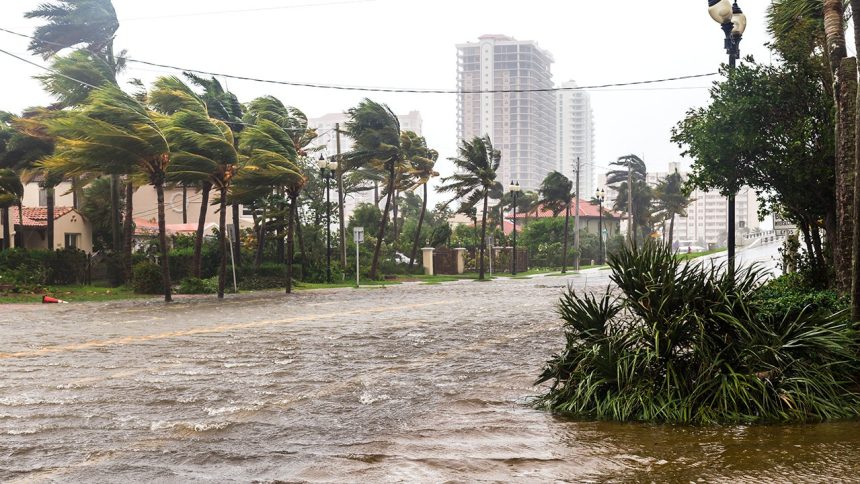Floridians are no strangers to hurricanes. For six months every year, Florida homeowners buckle down for high winds, possible flooding, heavy rains and rip currents. Hurricanes can be destructive, and knowing how your home insurance financially protects your home is an essential part of hurricane prep. Bankrate’s editorial rounded up all of the information Florida homeowners need to know about hurricane season 2025.
Hurricane season 2025
Florida hurricane season 2025 is expected to have above-normal levels of hurricane activity in the Atlantic. NOAA is predicting between 13 and 19 named storms this season, with approximately six to 10 of those expected to develop into hurricanes, and three to five of them are expected to be major hurricanes. NOAA calculates a 60 percent chance of an above-average season, a 30 percent chance of an average one and a 10 percent chance of a below-average one.
Living in the path of a hurricane comes with major financial risks, but understanding your home insurance policy can help mitigate some of those risks. Here’s the run-down of what you need to know about home insurance and hurricanes to help you prepare for the historic 2025 hurricane season:
- Homeowners insurance typically covers some forms of hurricane damage, but does not cover flood damage. Homes in high-risk areas may need windstorm insurance and flood insurance to avoid potential gaps in coverage. When a hurricane approaches, most insurance companies put a moratorium on increasing coverage or lowering deductibles until the storm passes.
- Bankrate’s hurricane resources aim to help you understand how your home insurance coverage may financially protect you from storm damage. These guides also provide tips to prepare your home for a storm and resources on how to file a claim for hurricane-related damage.
When is hurricane season in Florida in 2025?
Hurricane season in Florida is from June 1 to November 30. If you are wondering when peak hurricane season in Florida is, most activity is seen from August through October, where 96 percent of the major hurricane days occur from August to October, according to the NOAA. However, mid-September is generally more active with regard to tropical storms. Although damage caused by hurricanes can reach far inland in the U.S., states bordering a coast face higher risks. High-risk areas include the coastal regions of Florida, Texas, Mississippi and North Carolina according to the Federal Emergency Management Agency (FEMA).
2025 Hurricane season predictions
Each year, the NOAA publishes its predictions for that year’s hurricane season. This year, it is predicting a 60 percent chance of “above normal” hurricane activity. Here’s what that actually looks like:
- 13 to 19 named storms, with winds of 39 mph or higher.
- Of those named storms, six to 10 are expected to become hurricanes with winds of 74 mph or higher.
- Three to five major hurricanes, which are category 3, 4 or 5 on the Saffir-Simpson Hurricane Wind Scale. Winds can be 111 mph or higher.
Notable hurricanes in Florida’s history
Florida has a lengthy history of hurricanes, with the first recorded hurricane back in 1523. It is estimated that around 120 tropical storms have blown near or over Florida, making it the most hurricane-prone state in the country. Some hurricanes are simply an inconvenience to residents, while others can devastate entire communities. The table below illustrates estimated property losses (both insured and uninsured) for some of Florida’s most notable storms:
| Hurricane | Year | Category | Property damage |
|---|---|---|---|
| Andrew | 1992 | 5 | $60.2 billion |
| Ivan | 2004 | 3 | $33.8 billion |
| Charley | 2004 | 4 | $26.6 billion |
| Wilma | 2005 | 3 | $30.0 billion |
| Irma | 2017 | 4 | $63.5 billion |
| Micheal | 2018 | 5 | $31.0 billion |
| Ian | 2022 | 4 | $118.5 billion |
| source: NOAA |
Hurricane risks to be aware of
Hurricanes carry with them a variety of potential threats, and knowing how to handle each of them is a big part of being prepared for the season. Here are some of the risks you should be aware of if you live in coastal Florida:
-
High winds
To be considered a hurricane, a storm must have sustained winds of 74 mph or greater. At that speed, winds can seriously damage your roof, cause your home to shift and leave cracks in the foundation and significantly damage infrastructure such as power lines. The inside of your home may also sustain damage as high winds may damage windows and doors, allowing rain and flying debris to enter your home. Since Florida is relatively flat, winds may remain strong even on the state’s inland. -
Flooding
The amount of flooding you’re likely to experience in a hurricane is relative to how fast the storm moves. A slow-moving storm can dump many inches of rain in one location. As is true of high winds, even locations hundreds of miles away from the center of the storm may experience flooding. However, remember that standard homeowners insurance does not cover flood damage, and a supplemental flood policy may be a good idea if you live in a region with frequent hurricanes. You may be required to purchase flood insurance if you live in a high-risk flood zone. -
Storm surge
Storm surge can be caused by hurricanes, resulting in an abnormal rise of seawater that gets pushed towards the shore. Combined with the effects of the high winds and tidal action, this wall of water can be as high as 25 feet above the normal sea level. The majority of deaths in hurricanes are caused by individuals who cannot escape from surges or flooding. If you live in an area that sees frequent hurricanes, it’s important to know if you live in an evacuation zone, where you might be ordered to leave your home in the event of a storm to protect yourself and your family.
Getting the right home insurance for hurricane season in Florida
It’s important to take time to search for coverage, especially with Florida’s home insurance market crisis. Considering Florida’s status as the number one hurricane-prone state, Florida residents would do well with having a robust homeowners insurance policy to be financially prepared. Depending on your location in the state, you may need multiple types of policies such as flood insurance, which must be purchased separately from your homeowners insurance.
Standard home policies generally cover wind damage. However, Florida residents may need to pay a separate deductible for this coverage. The deductible may be a specific amount, or a percentage of your dwelling coverage. So, for example, if you have $300,000 in dwelling insurance and your wind deductible was 2 percent, you would pay up to $6,000 out of pocket for windstorm damage to your home.
Regional hurricane risks in Florida
Different parts of Florida are at various risk levels for experiencing hurricane severity. For instance, although it faces the Gulf, the southwest coastline of Florida is among the most at-risk areas in the state for hurricanes. From most to least, the highest risk areas tend to be the Florida Keys, the southeast coast and the southwest coast, followed by the panhandle. Other parts of Florida are also at risk, but the odds of experiencing a severe hurricane are highest in those regions mentioned.
Common types of hurricane damage
There are different kinds of hurricane damage that can affect your home, which can result in the need for extensive repairs. When a hurricane makes landfall, the average sustained wind speeds will typically range from 74 to 150 mph. With stronger storms, winds may exceed 200 mph. Wind damage is likely if your home is in the path of a hurricane. Structural damage, like damage to your roof or siding, is also common.
Flood damage is a significant risk with hurricanes. Storm surges and heavy rains may cause extensive damage to both the interior and exterior of your home. In severe cases, flooding may even lead to a total loss.
Depending on the category of the storm, hurricanes can cause upwards of $2 billion in damage and are one of the most common natural disasters.
How to prepare your home for a hurricane
In addition to knowing when hurricane season occurs, you’ll want to make sure you take steps to prepare your home for potential hurricanes ahead of time. There are several ways you can help protect your property, such as by raising your furniture to avoid flood damage, ensuring your roof is in good condition and researching your area’s risk analysis to help you prepare against likely causes of damage.
Ahead of a storm, prepare a storm kit of food, water and other essentials to hold you over if you need to evacuate. FEMA recommends a minimum three-day supply of food and water, but you should gauge your need for more based on the size of your family, pets and location.
Frequently asked questions
Why we ask for feedback
Your feedback helps us improve our content and services. It takes less than a minute to
complete.
Your responses are anonymous and will only be used for improving our website.
Help us improve our content
Read the full article here
















